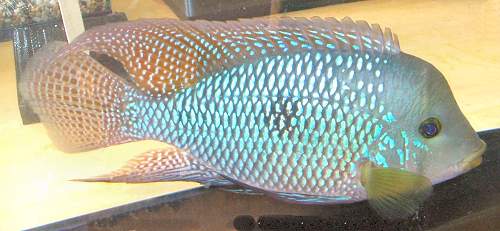
Common name: Pearl Cichlid, Pearlscale Eartheater
Scientific name: Geophagus Brasiliensis
Average Adult Fish Size: 8 inches / 20 cm
Place of Origin: East and southeast of Brazil
Typical Tank setup: Plenty of gravel and open swimming space, maybe a few plants with rocks and bogwood too.
Recommended Minimum Aquarium Capacity: 100 gallon / 400 litre
Compatibility: This fish will inevitably be moved from the genus Geophagus and it is not advisable to keep them with other true Geophagus. Geophagus brasiliensis is a more boisterous tankmate and certainly more aggressive at feeding time. Although aggressive for Eartheater standards, it is not aggressive when compared to Central American cichlids.
Temperature: / 75 – 88 Deg F / 24 – 27 Deg C
Water chemistry: pH 6.0 – 8.0
Feeding: Studies have revealed it to be a generalised omnivore with the natural diet composed of plant material, aquatic invertebrates (particularly chironomid larvae, ostracods and cladocerans), fish scales and fry.
Although often referred to as an ‘eartheater’ this species isn’t as benthophagous as members of Geophagus though mouthfuls of substrate are sometimes taken and sifted for edible items.
In the aquarium offer good quality, sinking dry foods as staple alongside regular meals of live or frozen bloodworm, Artemia, etc.
Sexing: Males grow larger than females, often significantly so, and most dominant specimens develop a nuchal hump to some extent.
Breeding: Substrate Spawner.
Additional Information: A great beginner fish, as it is not very picky about water conditions.
This species is also known as the ‘pearlscale’ or ‘mother-of-pearl’ cichlid in deference to the iridescent body scaling.
It’s also worth noting that fishes sold as Gymnogeophagus australis in Europe are ‘G.‘ brasiliensis more often than not.
Wild specimens exhibits significant dissimilarities in body colour and patterning depending on locality with basic colouration being dominated by varying shades of blue, green or yellow, for example.
Some populations also exhibit differences in body shape depending on the type of environment they inhabit, e.g., specimens from fast-flowing rivers and tributaries are more elongate than those from sluggish or stagnant waters.


Related Posts
Croaking Gourami – Trichopsis vittatus
Paradise Fish – Macropodus opercularis
Schubert’s Barb – Barbus Semifasciolatus